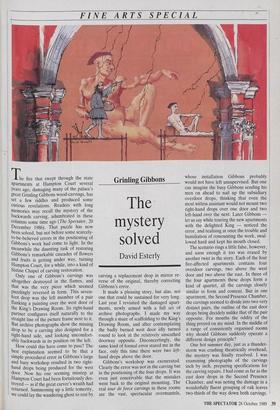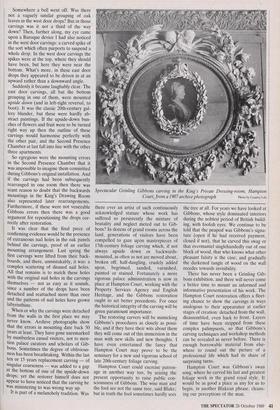FINE ARTS SPECIAL Grinling Gibbons
The mystery solved
David Esterly The fire that swept through the state apartments at Hampton Court several years ago, damaging many of the palace's great Grinling Gibbons wood-carvings, has set a few riddles and produced some curious revelations. Readers with long memories may recall the mystery of the backwards carving, adumbrated in these columns some time ago (The Spectator, 20 December 1986). That puzzle has now been solved, but not before some scarcely- to-be-believed errors in the positioning of Gibbons's work had come to light. In the meanwhile the daunting task of restoring Gibbons's remarkable cascades of flowers and fruits is getting under way, turning Hampton Court, for a while, into a kind of Sistine Chapel of carving restoration.
Only one of Gibbons's carvings was altogether destroyed in the flames, and that was the very piece which seemed puzzlingly reversed in form. This seven- foot drop was the left member of a pair flanking a painting over the west door of the King's Drawing Room. Its right-hand Partner configures itself naturally to the straight line of the picture frame next to it. But archive photographs show the missing drop to be a carving also designed for a right-hand side, and looking uncomfort- ably backwards in its position on the left. Flow could this have come to pass? The best explanation seemed to be that a simple procedural error in Gibbons's large and busy workshop resulted in two right- hand drops being produced for the west door. Now his one seeming misstep at Hampton Court had been fortuitously des- troyed — as if the great carver's wraith had returned. Summoning up a little temerity, we could lay the wandering ghost to rest by. carving a replacement drop in mirror re- verse of the original, thereby correcting Gibbons's error.
It made a pleasing story, but alas, not one that could be sustained for very long. Last year I revisited the damaged apart- ments, newly armed with a full set of archive photographs. I made my way through a maze of scaffolding to the King's Drawing Room, and after contemplating the badly burned west door idly turned round to look at the relatively unscathed doorway opposite. Disconcertingly, the same kind of formal error stared me in the face, only this time there were two left- hand drops above the door. Gibbons's workshop was exonerated. Clearly the error was not in the carving but in the positioning of the four drops. It was even just conceivable that the mistakes went back to the original mounting. The real tour de force carvings in these rooms are the vast, spectacular overmantels,
whose installation Gibbons probably would not have left unsupervised. But one can imagine the busy Gibbons sending his men on ahead to nail up the subsidiary overdoor drops, thinking that even the most witless assistant would not mount two right-hand drops over one door and two left-hand over the next. Later Gibbons let us say while touring the new apartments with the delighted King — noticed the error, and realising at once the trouble and humiliation of remounting the work, swal- lowed hard and kept his mouth closed.
The scenario rings a little false, however, and soon enough it too was erased by another twist in the story. Each of the four fire-affected apartments contains four overdoor carvings, two above the west door and two above the east. In three of the four apartments these drops form a kind of quartet, all the carvings closely similar in form and content. But in one apartment, the Second Presence Chamber, the carvings seemed to divide into two very distinct pairs, the outline of the east door drops being decidely unlike that of the pair opposite. For months the oddity of the thing preyed on my mind. In the middle of a range of consistently organised rooms why should Gibbons suddenly operate a different design principle?
One hot summer day, just as a thunder- storm was crashing theatrically overhead, the mystery was finally resolved. I was examining photographs of the carvings inch by inch, preparing specifications for the carving repairs. I had come as far as the east door drops in the Second Presence Chamber, and was noting the damage in a wonderfully fluent grouping of oak leaves two-thirds of the way down both carvings. Somewhere a bell went off. Was there not a vaguely similar grouping of oak leaves in the west door drops? But in those carvings was it not a third of the way down? Then, further along, my eye came upon a Baroque device I had also noticed in the west door carvings: a carved spike of the sort which often purports to suspend a whole drop. In the west door carvings the spikes were at the top, where they should have been, but here they were near the bottom. What's more, in these east door drops they appeared to be driven in at an upward rather than a downward angle.
Suddenly it became laughably clear. The east door carvings, all but the bottom grouping in one of them, were mounted upside down (and in left-right reversal, to boot). It was the classic 20th-century gal- lery blunder, but these were hardly ab- stract paintings. If the upside-down bun- ches of flowers and fruit were to be turned right way up then the outline of these carvings would harmonise perfectly with the other pair, and the Second Presence Chamber at last fall into line with the other three apartments.
So egregious were the mounting errors in the Second Presence Chamber that it was impossible to imagine them committed during Gibbons's original installation. And if the carvings had been subsequently rearranged in one room then there was scant reason to doubt that the backwards mountings in the King's Drawing Room also represented later rearrangements. Furthermore, if these were not venerable Gibbons errors then there was a good argument for repositioning the drops cor- rectly after restoration.
It was clear that the final piece of confirming evidence would be the presence of extraneous nail holes in the oak panels behind the carvings, proof of an earlier mounting arrangement. Last spring the first carvings were lifted from their back- boards, and there, unmistakably, it was: a complex scattering of disused nail holes. All that remains is to match these holes with the original nail holes in the carvings themselves — not as easy as it sounds, since a number of the drops have been detached and reattached more than once and the patterns of nail holes have grown labyrinthine.
When or why the carvings were detached from the walls in the first place we may never know. Archive photographs show that the errors in mounting date back 50 years at least. They have gone unremarked by numberless casual visitors, not to men- tion palace curators and scholars of Gib- bons. Sometimes the degree of oblivious- ness has been breathtaking. Within the last ten or 15 years replacement carving — of singular coarseness — was added to a gap at the bottom of one of the upside-down drops; yet the restorer himself does not appear to have noticed that the carving he was ministering to was wrong way up. It is part of a melancholy tradition. Was Spectacular Grinling Gibbons carving in the King's Private Dressing-room, Hampton Court, from a 1907 archive photograph Photo by Country Lifc
there ever an artist of such continuously acknowledged stature whose work has suffered so persistently the mixture of brutality and neglect meted out to Gib- bons? In dozens of grand rooms across the land, generations of visitors have been compelled to gaze upon masterpieces of 17th-century foliage carving which, if not always upside down or backwards- mounted, as often as not are moved about, broken off, half-dangling, crudely added upon, begrimed, sanded, varnished, painted or stained. Fortunately a more rigorous palace administration is now in place at Hampton Court, working with the Property Services Agency and English Heritage, and the Gibbons restoration ought to set better precedents. For once the historical integrity of the carving will be given paramount importance.
The restoring carvers will be mimicking Gibbons's procedures as closely as possi- ble, and if they have their wits about them they will come out of this immersion in the man with new skills and new thoughts. I have even entertained the fancy that Hampton Court may prove to be the seminary for a new and vigorous school of late 20th-century foliage carving.
Hampton Court could exercise patron- age in another way too, by seizing the present opportunity to raise public con- sciousness of Gibbons. The wise man and the fool see not the same tree, said Blake; but in truth the fool sometimes hardly sees the tree at all. For years we have looked at Gibbons, whose style dominated interiors during the noblest period of British build- ing, with foolish eyes. We continue to be told that the peapod was Gibbons's signa- ture (open if he had received payment, closed if not), that he carved this swag or that overmantel singlehandedly out of one block of wood, that who knows what other pleasant falsity is the case; and gradually the darkened tangle of wood on the wall recedes towards invisibility.
There has never been a Grinling Gib- bons exhibition, and there will never come a better time to mount an informed and informative presentation of his work. The Hampton Court restoration offers a fleet- ing chance to show the carvings in ways analogous to their appearance at earlier stages of creation: detached from the wall, disassembled, even back to front. Layers of time have been stripped from these complex palimpsests, so that Gibbons's carving techniques and workshop methods can be revealed as never before. There is enough borrowable material from else- where to round out the picture of a professional life which had its share of surprising turns.
Hampton Court was Gibbons's swan song, where he carved his last and greatest foliage work in the grand royal style. It would be as good a place as any for us to begin, in another Blakean phrase, cleans- ing our perceptions of the man.



































































 Previous page
Previous page